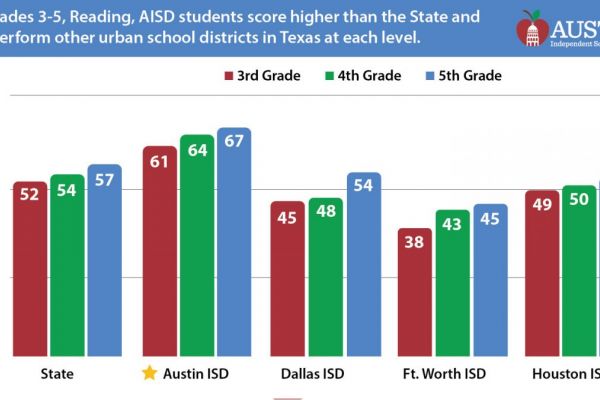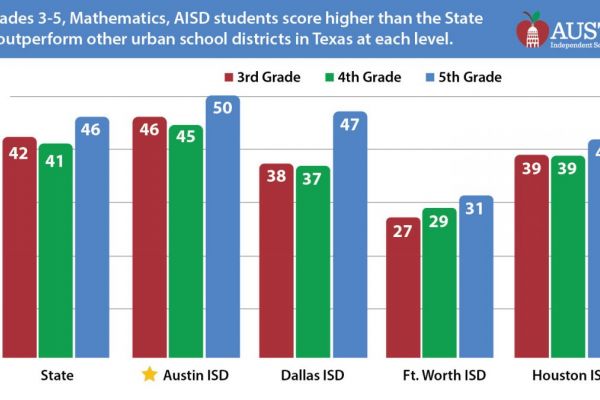By Paul Stinson
Austin ISD students in elementary reading are making longer strides toward pre-pandemic recovery than their statewide counterparts, while still facing an uphill climb to reclaim 2019 achievement levels in math and science, newly published data shows.
Austin ISD students eclipsed the statewide average in third grade reading scores by 9%, according to a presentation authored by Austin ISD Interim Superintendent Dr. Anthony Mays. That margin of proficiency grew even further when compared to big city counterparts, with Austin ISD outperforming districts in Dallas (+16%), Ft. Worth (+23%) and Houston (+12%).
“We’re not surprised that all the hard work our teachers and students put in last year helped our third graders recover from the pandemic on reading,” said Elizabeth Casas, Chief Academic and School Leadership Officer. “That Austin did so much more than our peer districts, however, was startling. This is very good news.”
Overall, elementary reading scores for the district show 2022 testing scores surpassing pre-pandemic performance in five out of six student groups, with African American students surpassing pre-pandemic 2019 levels by 2% after scoring 13 points higher than 2021 results. Reading scores for Hispanic students also exceeded pre-pandemic levels by 4% after scoring 15 points higher than the year previous.
Although 2022 scores marked an eclipsing of pre-pandemic performance, significant achievement gaps remain relative to white students, with data showing deficits by African American and Hispanic students relative to white students of 48% and 40%, respectively.
“Reducing these gaps is central to our mission. We have high expectations for all children and know that every child can achieve high outcomes. Our mission is to make our reality match our vision,” said Casas.
Widening the scope of reading scores to include Grades 3-5, Austin ISD students also scored higher than the state while eclipsing marks set by other urban school districts.
Data detailing pre-pandemic recovery efforts in elementary math was less rosy, showing increases from 2021 to 2022 in five out of six student groups, but still lagging significantly behind pre-pandemic 2019 levels. African American, Hispanic, Economically Disadvantaged and Emergent Bilingual groups all posted 2022 scores resulting in gaps of 13%.
“Math and science are different animals than reading,” said Casas. “Once you learn to read, you build on that skill. Math and science require constantly learning new skills. For example, geometry requires different skills than long division. Getting kids caught up on math and science is going to take a little longer, but we’re making better progress than other large school districts in Texas, and I’m confident that we’ll get there.”
Special Education and White student groups in elementary math also fell short of pre-pandemic levels by 12 and six percentage points, respectively. Scores for Special Education students dropped two points from their 2021 levels, widening the gap to pre-pandemic performance scores to 12%.
And while significant gaps remain between 2022 math scores and pre-pandemic levels, AISD students in grades 3-5 outperformed the state in that subject by 4% and scored higher than their urban counterparts by margins ranging from the 3% to 19%.
Overall elementary scores in science also show a lag behind the pre-pandemic levels across all six student groups. While five out of six groups posted 2022 increases over their 2021 levels, African American and Economically Disadvantaged student groups posted testing marks short of 2019 levels by
15% and 14%, respectively. Hispanic and Emerging Bilingual student groups posted levels lagging behind pre-pandemic levels by 12%, while the gap for white students decreased to four percentage points.



